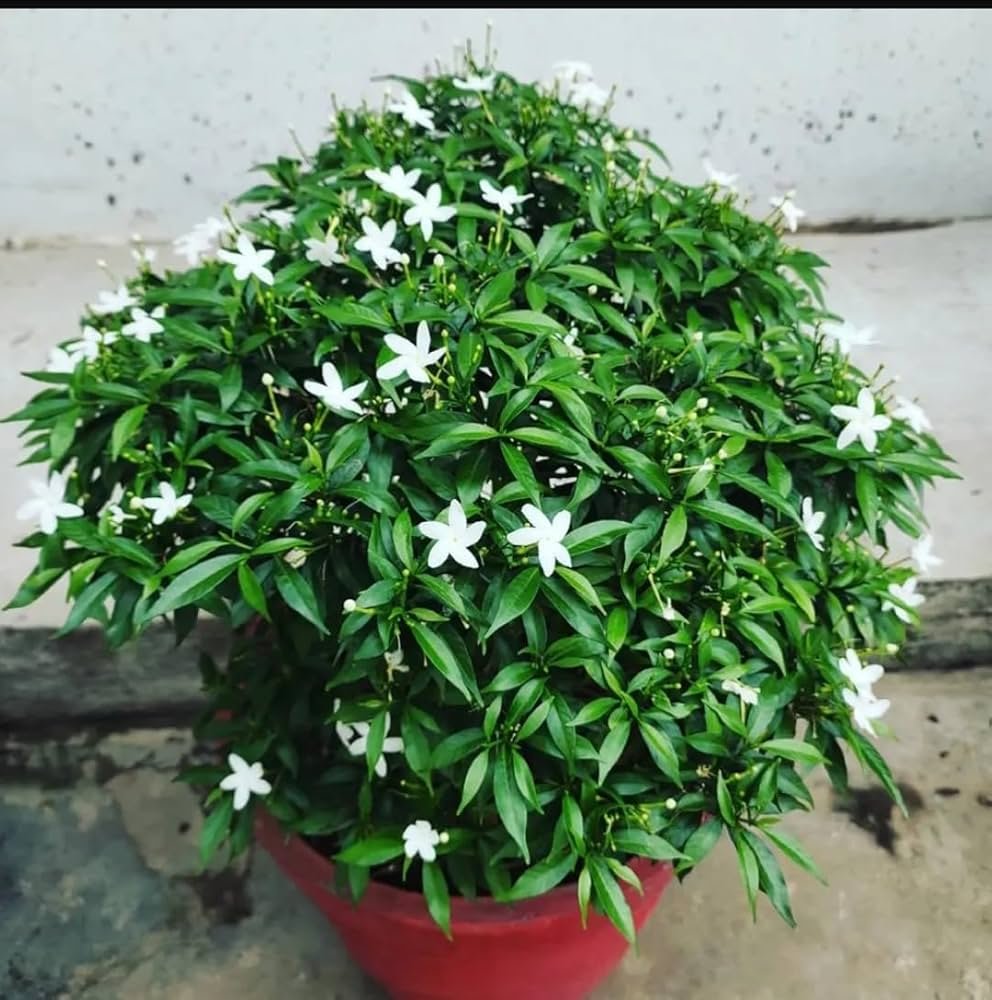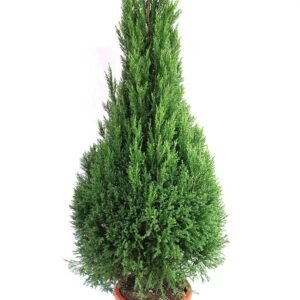Description
Mini Tagar Plant
The Mini Tagar plant, also known as Dwarf Tagar, Mini Crepe Jasmine, or Pinwheel Jasmine, is a beautiful, compact, evergreen shrub admired for its ornamental value, lush foliage, and fragrant white flowers. A dwarf cultivar of Tabernaemontana divaricata, it belongs to the Apocynaceae family and is native to the Indian subcontinent and Southeast Asia. The plant is widely cultivated in gardens, homes, and landscapes due to its manageable size, year-round greenery, and spiritual symbolism in Indian culture.
Botanical Description
The Mini Tagar is a smaller version of the traditional Tagar or Crepe Jasmine plant. While the regular Tagar can grow to over 6 feet tall, the Mini Tagar reaches a height of just 1.5 to 3 feet, making it ideal for small spaces, pots, and borders.
Foliage
The plant features shiny, dark green leaves that are elliptical and leathery in texture. The dense foliage adds to its ornamental charm, providing a rich green backdrop for the bright white flowers. Leaves are arranged oppositely, with a prominent midrib, and are about 2 to 4 inches long.
Flowers
The Mini Tagar blooms profusely, especially during the summer and monsoon months. Its white, pinwheel-shaped flowers are not only attractive but also mildly fragrant. Each flower has five twisted petals that resemble a spinning pinwheel, hence the name “Pinwheel Jasmine.” The flowers are usually solitary or appear in small clusters and are around 1 to 1.5 inches in diameter.
One notable feature of the Mini Tagar is that it does not produce seeds as frequently as the regular variety. It is typically propagated through stem cuttings, which root easily in warm, humid conditions.
Growth and Care Requirements
The Mini Tagar is considered a low-maintenance plant, making it popular among both novice and experienced gardeners.
Sunlight
Mini Tagar plants thrive in bright sunlight. They prefer 6 to 8 hours of full sun daily but can tolerate partial shade. When grown indoors, placing the pot near a south- or west-facing window ensures optimal light exposure.
Soil
The plant prefers well-draining, fertile soil rich in organic matter. A mix of garden soil, compost, and sand or perlite works well. It does not tolerate waterlogged soil, which can lead to root rot.
Watering
Watering should be done moderately. The soil should be kept slightly moist but not soggy. During summer, it may require more frequent watering, while in winter, watering can be reduced. A good rule of thumb is to water when the top inch of the soil feels dry.
Fertilization
For lush foliage and continuous blooming, fertilize the plant once a month with a balanced liquid fertilizer or organic compost during the growing season (spring to early autumn). Avoid over-fertilization, as it may lead to excessive leaf growth at the expense of flowers.
Pruning
Regular pruning and pinching help maintain the compact shape of the Mini Tagar and encourage bushier growth. Remove dead or yellowing leaves and spent flowers to keep the plant healthy and tidy.
Pests and Diseases
The Mini Tagar is generally pest-resistant, but it can occasionally be affected by aphids, mealybugs, or spider mites. Neem oil spray or mild insecticidal soap can be used to manage these pests naturally. Overwatering may lead to root rot or fungal infections, so good drainage is crucial.
Propagation
The most common method of propagating the Mini Tagar is through stem cuttings. Cut a healthy 4-6 inch long stem just below a node, remove the lower leaves, and place it in moist soil or water until roots develop. Rooting hormone may be used to speed up the process. Once rooted, the new plant can be transferred to a pot or directly into the ground.
Uses and Benefits
The Mini Tagar is prized primarily for its ornamental value, but it also holds cultural, spiritual, and medicinal significance.
1. Ornamental Use
- Ideal for border planting, hedges, and container gardening.
- Commonly used in terrace gardens, balconies, and indoor decoration.
- Its compact size and attractive blooms make it a preferred choice for bonsai and topiary art.
2. Spiritual and Cultural Use
- The white flowers of Tagar are often used in Hindu religious ceremonies.
- Offered during poojas and rituals as a symbol of purity and devotion.
- In some Indian traditions, Tagar flowers are strung into garlands for temple offerings.
3. Medicinal Properties
While the dwarf variety is not extensively used medicinally, the traditional Tagar (Crepe Jasmine) has recognized uses in Ayurveda:
- Used as an anti-inflammatory agent.
- Latex from the plant has been applied to skin ailments like wounds and boils.
- Root extracts are known for their sedative and analgesic properties.
Note: Despite traditional uses, self-medication is not advised, as parts of the plant can be toxic if consumed improperly.
Environmental and Aesthetic Impact
- The Mini Tagar is a pollinator-friendly plant. Its fragrant blooms attract bees and butterflies.
- It enhances air quality by producing oxygen and absorbing pollutants when grown in indoor or urban settings.
- As a low-maintenance shrub, it helps reduce the need for chemical fertilizers or pesticides, promoting eco-friendly gardening.
Landscape Applications
Landscape designers and home gardeners often use Mini Tagar for:
- Formal gardens: Due to its symmetrical shape and neat appearance.
- Zen or tropical gardens: Its lush leaves and soft white blooms complement minimalist designs.
- Mass planting: When planted in groups, it forms a dense, flowering carpet.
Container Gardening
The Mini Tagar is especially well-suited for container gardening:
- Can be grown in pots ranging from 8 to 14 inches in diameter.
- Ideal for patios, balconies, and verandas.
- Easily moved indoors during colder months in temperate climates.
Conclusion
The Mini Tagar plant is a perfect example of a low-maintenance, high-reward ornamental shrub. With its delicate white flowers, glossy green leaves, and compact stature, it brings beauty, tranquility, and a touch of spirituality to any space it inhabits. Whether planted in a garden, kept in a balcony pot, or used in landscape design, this dwarf variety of the beloved Tagar plant continues to charm gardeners and plant lovers across the globe.







Reviews
There are no reviews yet.